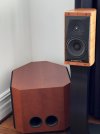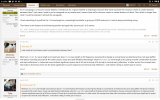It works with wavelength. 100Hz is 3.4m long, or about 11 feet. Direct sound and a reflection have different path length to ear, thus they would interfere constructively when they are roughly in phase at some particular frequency (wavelength) or destructively when they are out of phase. What is in phase then? perhaps if the two have only about 1/4wavelength path length difference, which means 90deg phase difference, which means they would interfere constructively.
At 1/2 wl path length difference phase of the later sound would be 180deg, so completely out of phase and destructive interference. At 1wl path length differemce they'd be in phase, 1.5wl out of phase etc, a comb filter.
So, at 100Hz a singular reflection would sum constructively with direct sound if it arrives to ear less than 3.4m/4 = 85cm after direct sound, 2.5ms of spund travel. At 200Hz this would be roughly 42cm, 400Hz about 21cm, and so on.
Simplified, sound reflects like light from a mirror so you can use simple trigonometry to calculate path lengths. Notice how 100Hz is about size of a room, ecpect reflections from all room boundaries, from all objects for wavelengths that are comparable in size, and so on, so it gets rather complex quick. How it sounds? it sounds like a mess inside a room, just like yoi hear it. Take your set outside and have a listen, notice a difference?

In general, sound interacts with physical objects when they are close in size. Low frequencies are omni because wavelength is (much) longer than size of the speaker, thus the speaker is invisible acoustically, and sound radiates to all directions. When wavelength is smaller than the speaker, the box has strong effect acoustically, and there is some shadow behind, edge diffraction and so on, sound interacts with the box.
The 1/4wl rule is kind of easy to remember and approximate with. Reflection is less than that behind direct sound, and its good for all frequencies below. Frequencies above this problems start, comb filter.
Another, your room dominates low frequency sound making it bad, as they are about same size. And your speaker box being about size of midrange sound makes sure the whole midrange is also full of issues. Difference between good and worse system is how you deal with such things, and system is not just the speakers but how they are setup in a room and how they work together so sound at your ear was maximally enjoyable. If you like music, it's likely enjoyable what ever the quality is.
It's all about wavelength. Have fun!






.jpg)
.png)